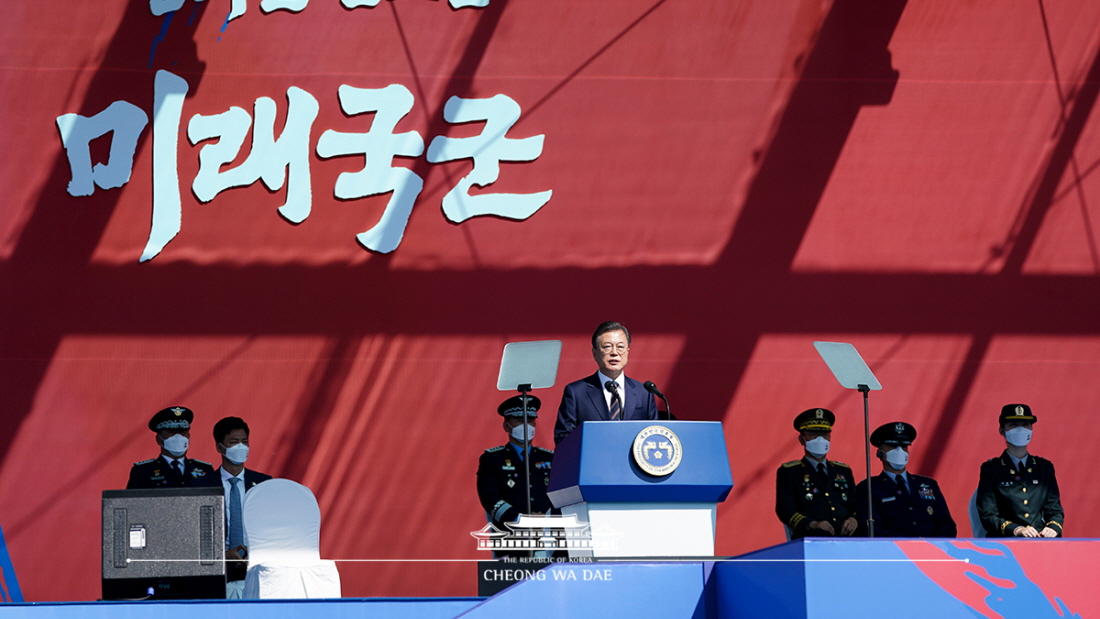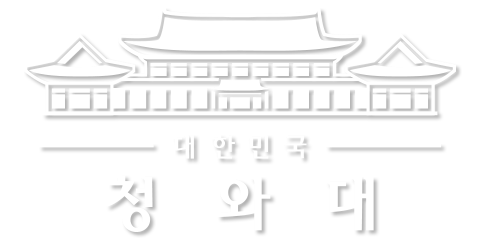이 웹사이트는 제19대 대통령 임기 종료에 따라 대통령기록관이 「대통령기록물 관리에 관한 법률」에 의해 이관받아 서비스하는 대통령기록물입니다. 자료의 열람만 가능하며 수정 · 추가 · 삭제는 불가능합니다.
다만, 「개인정보보호법」에 의하여 개인의 정보를 보호받기 원하시는 분은 관련 내용(요청자, 요청내용, 연락처, 글위치)을 대통령 웹기록물 담당자(044-211-2253)에게 요청해 주시면 신속히 검토하여 조치해 드리겠습니다. 감사합니다.
SPEECHES & REMARKS
BRIEFINGS

Fellow Koreans, our men and women in uniform,
We are holding the 72nd Armed Forces Day ceremony here at the Republic of Korea Army Special Warfare Command for the first time in history. Today, I am very pleased to celebrate Armed Forces Day with special warfare troops and present a future vision of our Armed Forces to the people. I’d like to send encouragement to our military service members at home and abroad who are dedicating themselves, even at this moment, to national security and world peace. I am also deeply grateful to war veterans, reservists, the United Nations Korean War veterans and the members of the United States Forces Korea.
We cannot forget for even an instant that today’s Republic of Korea has been built on the sacrifice of our patriotic forebears. I pay special tribute to the guardian spirits of the country and their bereaved families. In particular, I pray for the eternal peace of the souls of the 478 special warfare heroes who faced glorious deaths while fulfilling their duties.
Fellow Koreans,
Our Special Forces are the Republic of Korea’s leading special warfare unit. Each of these honorable units has inherited the legacy of commandoes from the 8240 Guerilla Unit, also known as the KLO Unit. During the Korean War, they fought and risked their lives without ever receiving service numbers or ranks. Steeled by harsh, real-combat-like training that is more rigorous than actual battle, our Special Forces warriors are confident that they can take on the enemy even if outnumbered one hundred to one. “Make what is impossible possible” – this spirit serves as the strength that leads them to carry out their missions successfully, and it also imbues the people with pride.
Just as our Armed Forces are rooted in the Korean Liberation Army, the history of Korea’s special warfare can be traced back to the KLA as well. In April 1945, KLA operatives began “Project Eagle” with the then U.S. intelligence agency Office of Strategic Services, the OSS. The sole aim of this military operation was to liberate their homeland. They went through grueling drills and were reborn as 38 special warfare warriors armed with demolition skills, marksmanship and the ability to conduct mountain guerilla warfare. Their operation could not be carried out because of Japan’s surrender. However, the KLA spirit that strove to soar like an eagle to establish a bridgehead for national liberation is still carried today in the hearts of our Armed Forces’ special warfare units.
The core combat strength of the Cheonghae Unit is the Republic of Korea Navy’s Special Warfare Flotilla. Through its Operation Gulf of Aden Dawn, it let the world know that the ROK Special Forces are capable and strong at actual warfare. Able to execute the absolute best underwater operations among our Armed Forces, the Navy’s Sea Salvage and Rescue Unit protects the lives and property of the people from extreme disasters and calamities. The Special Air Force Rescue Team is ready to rescue pilots under any adverse conditions. The Air Force’s Combat Control Team will be the first to infiltrate dangerous enemy territory at any given time to secure a bridgehead for seamless aerial operations.
Together with the Marine Corps Special Reconnaissance Unit, which plays a role as the eyes and ears of amphibious landing units, all of these special warfare units comprise irreplaceable, powerful and exceptional elite troops. Safeguarding the people’s lives and property in peacetime, they will complete whatever missions they are assigned even at the risk of their own lives. I am truly proud of all those in the special warfare units. I believe our people always feel secure. As Commander-in-Chief and a former Special Forces operative, I express my deepest trust in and affection for all of you.
Members of the Armed Forces,
A truly solid defense posture is not limited to front and rear lines. This year, in particular, everyone has been working so hard to maintain special readiness in the face of a new security threat caused by COVID-19 and natural disasters. Through the National Defense Support Group, our military has injected all the assets – personnel, facilities and equipment – that it could mobilize into epidemic prevention and control.
In some vulnerable areas, 32,000 troops have conducted epidemic prevention and control outreach by operating disinfectant sprayers and decontamination vehicles. Air Force cargo planes carried face masks and medical supplies to hospitals and clinics across the country and to Koreans overseas. The Air Force also brought Korean residents abroad back to their homeland safely.
It was the Army, Navy and Air Force that rushed to flooded areas hit by unusually long and strong monsoon rains and typhoons and led the recovery efforts. Above all, I would like to commend the incredible efforts you have made to prevent the spread of COVID-19 among soldiers. Our military has responded in an exemplary manner with measures that are stronger than the epidemic prevention authorities’ standards, and our soldiers put their comrades and country before anything else.
In the run up to one of Korea’s most important traditional holidays, soldiers are preserving steadfastly and remaining ever dedicated. Their relatives are missing them dearly due to the limits on visits and leaves. I would like to offer all of you comfort and encouragement.
Fellow Koreans,
Even in the face of the COVID-19 crisis, we are focusing on the economy and epidemic prevention and control with a belief in our country’s comprehensive, impregnable security capabilities.
I arrived here today on a tactical command vehicle – a first for a president of the Republic of Korea – escorted by such high-tech assets as tactical drones and unmanned combat vehicles that are being developed with our own technology.
You have just witnessed “future ROK Armed Forces building peace” through the grandeur of the helicopters filling the sky above today’s venue: These Apaches, the world’s strongest large attack helicopter, Blackhawks and Surions, Korea’s medium-sized utility helicopter, are operated by the special warfare units of the Navy and Air Force.
The ROK’s Armed Forces of the future must respond not only to conventional security threats but also to non-military threats such as infectious diseases like COVID-19, terrorism, disasters and catastrophes. In preparation for the new types and forms of warfare that will emerge in the era of the Fourth Industrial Revolution, we must accelerate the building of a digitalized powerful military and smart national defense.
The Government announced the mid-term plan for national defense last August to successfully complete “Defense Reform 2.0.” It contains our vision and aspirations to establish an “innovative and mighty force that protects and generates peace” by investing 301 trillion won over five years from 2021 through 2025. The strong power of the ROK Armed Forces in the future will be cultivated through our scientific and technological capabilities.
The ROK-U.S. missile guidelines were revised this year, paving the way for the use of solid fuel in space launch vehicles after the lifting of restrictions on Korea’s missile payloads. We plan to cultivate our ability to launch a reconnaissance satellite capable of monitoring potential threats in real time by using a solid fuel-powered space launch vehicle in addition to ANASIS-II, the ROK Armed Forces’ first military-only communications satellite.
We will defend our land with more accurate and powerful missiles that can fly farther than the 800-km-range ballistic and 1,000-km-range cruise missiles that our Army currently possesses.
A project to build a 30,000-ton level light aircraft carrier, which will serve as a multi-purpose military base for quick responses to transnational and non-military threats from abroad, will begin in earnest next year. This light aircraft carrier with nearly twice the transportation capacity of existing large cargo ships and our submarines that have significantly improved their capacities to carry weapons and navigate under water will protect not only the seas surrounding our country but also the maritime routes traveled by our people.
A prototype for the domestic fighter jet KF-X Boramae is in its final assembly stage. A prototype for the state-of-the-art AESA radar system, which is considered the eyes of a combat aircraft, has been released, and preparations for its integration with our new fighter jet are underway. When KF-X Boramae development is completed in 2026 as planned, the Republic of Korea will emerge as a country with strong air power and the world’s 13th nation possessing advanced fighter jets manufactured entirely from indigenous technology.
The Government will develop in earnest unmanned combat systems by using robots, drones, self-driving vehicles, AI and other Fourth Industrial Revolution technology. Small reconnaissance robots, unmanned search vehicles, unmanned submarines, autonomous underwater vehicles to detect naval mines, reconnaissance drones, communication-relay drones and mid-to-large assault drones will be deployed. They will be able to replace soldiers in dangerous operations such as searches and reconnaissance.
The Government has submitted to the National Assembly a 2021 military budget proposal that reflects Defense Reform 2.0 and the mid-term defense plan. It amounts to 52.9 trillion won, an increase of 5.5 percent in total from this year. In particular, the R&D budget for national defense – which will create the foundation for the future military – has risen by 8.5 percent to 4.25 trillion won. The amount earmarked for core technology development and support for localized development of various parts has increased considerably – up more than 50 percent from this year. The budget proposal also reflects ways to secure domestically manufactured, state-of-the-art weapons systems, respond to unconventional threats such as infectious diseases and to nurture the domestic defense industry.
The country should fulfill its responsibility to those young adults who are committed to carrying out their duties. The budget has been formulated to raise the monthly salary of sergeants to 608,500 won next year, and group health insurance for soldiers is scheduled to be introduced. The nation’s responsibility for diseases contracted during mandatory duty was strengthened. Medical support for serious or intractable illnesses that are first detected during service was also expanded. Applications for national merit or honor payments for veterans used to be accepted only after discharge, but the law and system have been upgraded to make submissions possible during one’s service. Injuries sustained while in the service will receive prompt care.
In line with the expectations of the new generation of soldiers, we will steadily continue efforts to significantly upgrade military culture, including service conditions and facilities as well as human rights issues. We will repay your dedication with unbreakable trust.
Fellow Koreans and men and women in uniform,
This year marks the 100th anniversary of victory for the battles of Fengwudong and Qingshanli. Following these great victories in the war for independence, fighters for independence risked their lives every single day to carry out armed resistance. This history of giving it one’s all in the defense of our country still continues unceasingly with soldiers in the Armed Forces today. The mission of protecting our nation lasts around the clock and cannot be entrusted to anyone else. Commemorating the 72nd Armed Forces Day today, we firmly pledge before the people that the ROK Armed Forces will be reborn as a mighty future military that promotes safety and the peace of our homeland.
Only when we establish an impregnable security posture with our own strengths can we build, protect and nurture peace. As we strengthen our security and readiness posture further, the Government and military promise the people that we will resolutely respond to any act that threatens their lives and safety.
I ask the people to stand together beside our imposing service members with ever more trust and respect.
Thank you.



